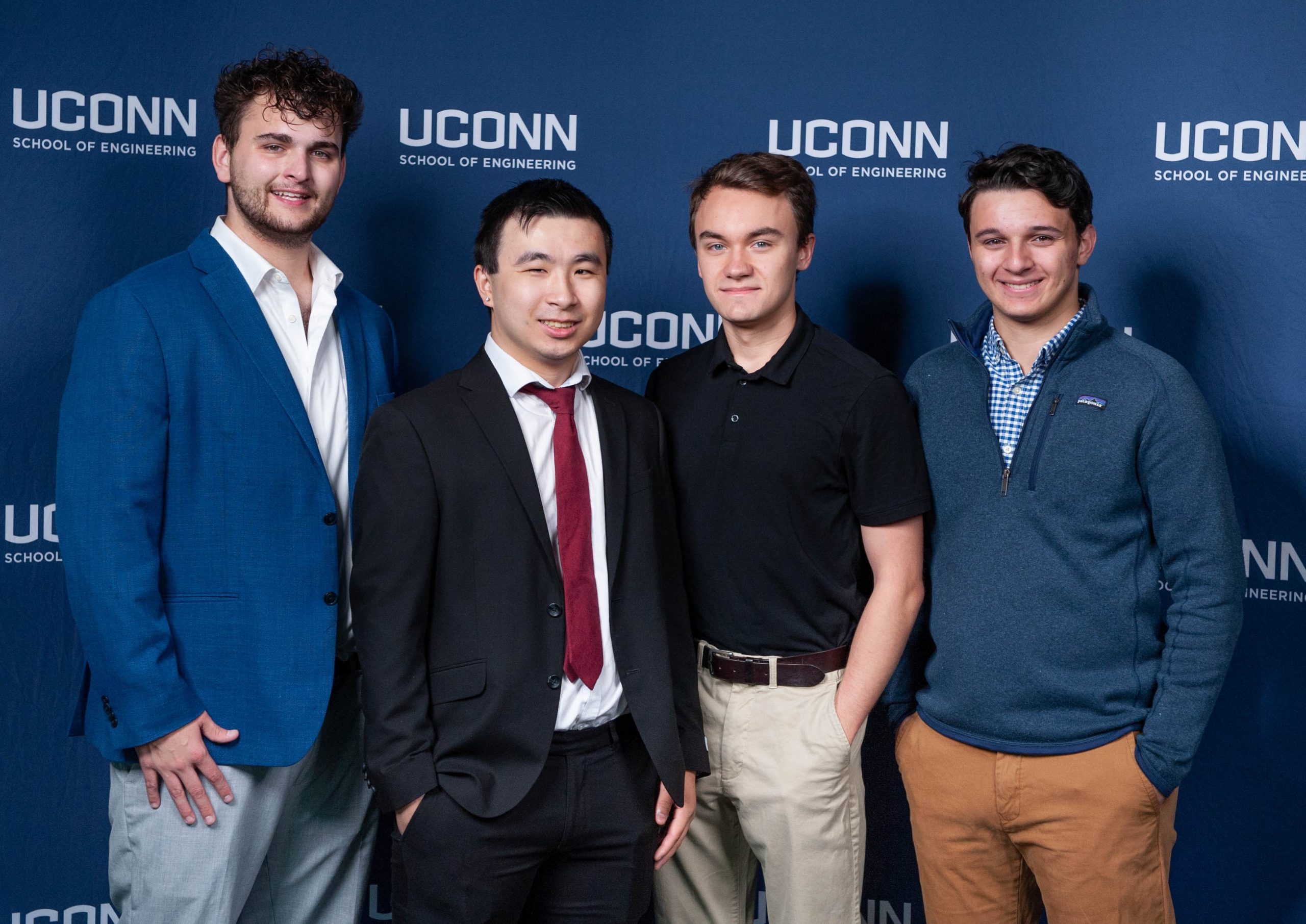The University of Connecticut School of Engineering engages faculty, senior-year students, and industry in a yearlong partnership to work on projects that result in innovative solutions to engineering challenges. For students, this experience is the culmination of their undergraduate education, and an opportunity to showcase their skills and education as they venture into the next steps of their careers. The Southern New England Industrial Assessment Center is sponsoring two projects for the 2022 – 2023 academic year, highlighted below.
Wireless Current Transducer for Remote Energy Monitoring: An IoT Device
Sponsor: Southern NE Industrial Assessment Center at UConn
Departments: Electrical/Computer Engineering (ECE) and Computer Science (CSE)
Members: Nicholas Satta (Team Lead, ECE), Yuchen Zhang (ECE), Zihao Fu (ECE), Carter Murray (CSE), Mathew Howlader (CSE), Christia Alvizio (CSE Team Lead)
Faculty Advisors: Liang Zhang (ECE)
Induction motors are the most widely used prime movers in typical industrial environments. To monitor the energy consumption of an AC induction motor, a commonly used approach is to measure the current drawn by the motor over a certain period of time by using a current transducer (CT). The CT, however, does not have data storage or transmission functions by itself. For that reason, a data logger must be used simultaneously. The data logger can read timestamped data collected by the CT and store it onboard for several weeks at a time. While modern data loggers have wireless communication capabilities using Bluetooth, it still requires a wired connection to the CT. Using Bluetooth or Wi-Fi, the user can access logger data, at any time, configure the logger, read out data, view data in graphs, check operational status, configure alarm notifications, and share data files.
During energy assessments conducted by the Southern New England Industrial Assessment Center (SNE-IAC), CTs and data loggers are required to be attached to various equipment to detect energy usage trends. It is desirable to have one single device for energy monitoring that can accomplish accurate current sensing, data storage, and reliable transmission to tabulate and graphically view data. This should all be contained in one unit, thus making it an internet-of-things (IoT) device. The objective of this project is to design and develop an IoT wireless current transducer with built-in data logging and transmission capabilities. This device will be deployed within an industrial manufacturing environment to remotely monitor energy usage and model trends.
The objective of this project is to design and develop an IoT wireless current transducer with built-in data logging and transmission capabilities. The ECE team will be responsible for incorporating a CT that can read current data at a user-selected sampling frequency which is stored on an integrated microcontroller. The device will be powered with a rechargeable LiPo battery with a power switch. A display will be incorporated for in-person monitoring in real-time as well as displaying battery power and wifi signal strength. The microcontroller will also wirelessly transmit data to the Arduino Cloud platform. The CSE team will be responsible for reading and storing the transmitted current data in the Arduino cloud to visualize data in graphical and tabular form.

Left to right: Zihao Fu, Carter Murray, Nicholas Satta, Christia Alvizio, Yuchen Zhang, Mathew Howlader
Developing a Digital Twin of the UConn Innovation Partnership Building
Sponsor: Eversource and Southern NE Industrial Assessment Center at UConn
Departments: Mechanical Engineering (ME) and Electrical/Computer Engineering (ECE)
Members: Jason Chen (Team Lead, ME), Jaden McDonnell (ME), William Cryan (ECE), Nicholas Janus (ECE)
Faculty Advisors: Ravi Gorthala (ME), Liang Zhang (ECE), Amy Thompson (SE)
The development of a digital twin of the Innovation Partnership Building (IPB) will offer UConn students the hands-on experience of applying modern digital engineering methods and practices to achieve higher-performing buildings in advanced lab spaces. A digital twin of the IPB will be a living virtual and digital image with data that can be accessed in intervals in real-time from the existing HVAC equipment, lighting, building management software, or sensors. This digital twin can be used for effective management of energy use, indoor air quality and comfort, space, security, and environmental impact, and can be used as a demonstration project to demonstrate best practices for operating and maintaining energy-efficient buildings, high-performing buildings
Students will develop an energy model of the building using EnergyPlus™, the DoE’s open-source whole-building energy modeling (BEM) engine, and the Department of Energy’s software following the modeling guidelines of ASHRAE/IESNA Standard 90.1-2007. The two building models will include all realistic elements of the building envelope, HVAC, laboratory/computer equipment, plug-loads, lighting, and occupancy. Students will collect data on specific aspects of the building by pulling interval data from the existing building management system or in combination by installing a new sensor network to collect data. Students will compare the validity of the two models and approaches and the effort to create and maintain them, comparing the model development process. The energy model will be validated by comparing its predicted energy use and energy intensity to actual energy use amounts during the historical period.
Once the energy models are developed, students will calibrate the models with actual historical building energy use data. Once validated, students can develop strategies and scenarios to improve energy efficiency, comfort, and the long-term health of the building. A digital twin can be updated with real data from its physical twin throughout its lifecycle and can therefore evaluate alternative scenarios that the physical building could encounter—for example a pandemic. The model will be calibrated to actual usage schedules, weather, and other conditions that the building experienced over a 12-month period. The digital twin will then be used to test stress scenarios for the building including, for example, high occupancy levels, longer occupancy schedules, extreme weather conditions, and specific types of equipment failure.

Left to right: Jaden McDonnell, Jason Chen, William Cryan, Nicholas Janus